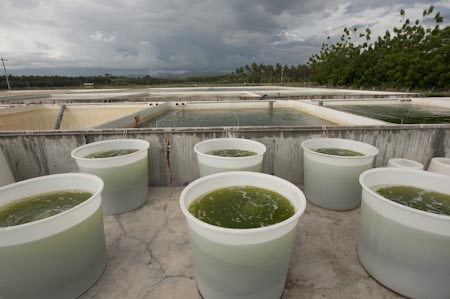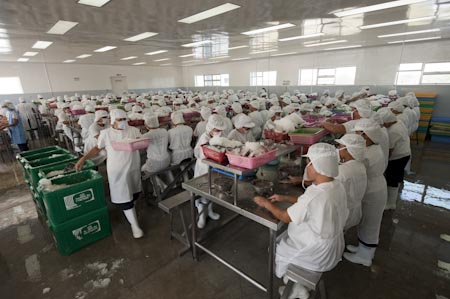29 April – 2 May 2010
We made a most interesting and educational trip to Sarangani Bay in Southern Mindanao to photograph aquaculture or aquafarming. Alsons Aquaculture Corporation is the producer of Sarangani Bay Prime Bangus or milkfish, which in the Philippines is food for the millions!
A full cycle aquaculture facility, Alsons operates from having milkfish spawners capable of supplying the market with 1.2 billion bangus fry annually, roughly 50% of the national requirement to finished local & export products of prime, vacuum packed boneless bangus! In a country that has a growing population of 92 million people, that is a big deal.
To explain further the significance of this, bangus is a REALLY boney fish which Filipinos LOVE. It is the Philippine National Fish. It is inexpensive because it is abundant. It is a sturdy fish which thrives and adapts even in fishponds.
We followed the whole bangus aquacuture process and through it, we realized what a crucial role this company holds – as the issue of food security and marine degradation stares us straight in the face.

From 12,000 spawners of various ages, eggs are spawned and hatched every day. This constantly aerated pond will have eggs floating on the surface for the technical farmers to harvest and relocated to the hatchery. They are fed prime algae and rotifers

The clear eggs are healthy and they like warm temperatures, hatching at night from 8 to 10pm. We literally saw them hatch into these wiggly fish shaped larvae which is still surrounded by its egg sac to feed it until it can feed on introduced algae & rotifers

Jingjing, the marine biologist of Finfish Hatchery proudly showed us a glass of algae soup. She said “this is really healthy algae. We only feed our babies the best algae!”

Rearing period to the fry stage is 21-25 days. Nutritious natural and formulated feeds are used to assure fry health.

Alsons uses 30 million fry to grow out and the rest are shipped to many bangus farms all over the country. Again, Alsons supply the 50% bangus fry requirement of the whole Philippines!!!
And then the fry is reared in-house either from grow-out sea cages or in fish ponds. They are fed with a soy based formula which is precisely measured to maximum productivity and minimum waste.

There were 45,000 bangus in this sea cage! We swam inside and they were a strong force to behold! Their swooshing sound underwater was awesome. Sea cages grow bangus slower than in ponds. But they are better in taste & quality, falling under the “premium” and more expensive category

A wall of powerful silver fish surrounded us. It was a great feeling to see so much fish. All 45,000 of them were our swim buddies!

Our wonderful guide is Alsons’ VP for Technical Services Mon Macaraig. Mon takes food from the mechanized soy based pellet feeder and throws it into the fishpond full of voracious eating bangus

They are fed from 8 am to 3 pm everyday. The depth of this pond is about a meter. The brackish water these fish are in is the mix of clean pristine waters of Sarangani Bay seawater and freshwater
And after about 7 months, the fishpond reared bangus are ready to be harvested. And after 9 months, the sea cage reared bangus are harvested.

This courageous man with a groin and face guard made of stainless steel brings together the net to take out the fish from the pond

They harvested about 4 tons of fish from this pond and was immediately put to ice and brought to the nearby processing plant for deboning and other processes

Maintaining a “cold chain” through the use of ice, freshly caught fish remain fresh all the way from processing to vacuum packing to storage and shipping

A massive workforce of expert deboners, this plant churns out products that is 60% for export market, mainly the Filipino communities living in North America and 40% are consumed locally

There are three parts of bones to take out to have boneless bangus. First is the main vertibrae, the second is the one that lines the stomach, and the third and most number of bones is the one found all along the back of the fish all neatly lined up for plucking
If you want to read an interesting blog entry about bangus, I have a favorite site called Market Manila. Have a good read and the comments are pretty interesting too! It gives an insight to Filipinos living in the Philippines and abroad!

Finally, because I am such a fan of this product, I have the pleasure of showing this well eaten product that is indeed fish for the millions!
If you want to keep updated with our new expedition blog entries, please sign up to our RSS feed by clicking here or clicking on the “Subscribe to this blog!” link at the top right of this page.
And to look up past entries, go all the way down and click into << older posts. Or go to the Archives on the upper right column of this page.




